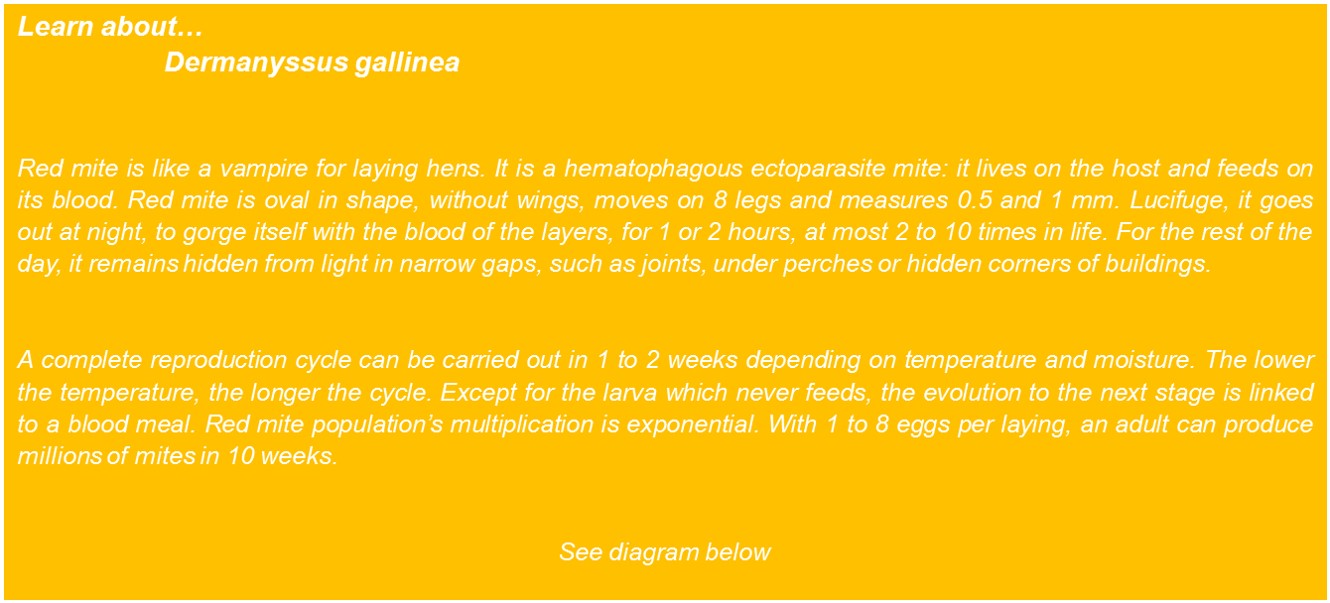Fighting red mites in laying hens: new alternatives available
Overview with Cyrille Henriet, Sales Manager for Altilis Nutrition Animale
Download the pdf file : Technical letter A.T.P.n°2 - Redmite management in laying hens
Since redmite is a major issue in laying hens, is there anything new? These parasites are known to be difficult to fight with great technical and economic consequences. Solutions are available: natural products applied through drinking water are gradually replacing contact chemicals. They seem to correspond to a growing expectation of the sector.
How often are red mite present on farms?
The problem is not geographically limited. In Europe, but also in the United States and Asia, as well as in the Middle East and Africa, red mite infestations are everywhere. Almost 80% of laying hens seem to be affected.
The older the buildings, the greater the risk. In old buildings, with a lot of wood, “corners” where mites can easily hide, the risk is greater. Nevertheless, modern buildings are not spared.
Main point to remember: it is not because you do not see them that they are not present. Mites don’t live on hens and they are often already there before we notice them.
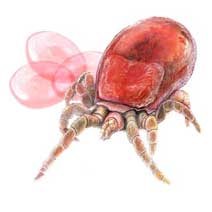
What is the technical impact of the red mite infestation in a breeding?
Red mite infestations have consequences that go far beyond laying performance reduction.
Indeed, mites are first and foremost a source of stress for the hen. The behaviour of the birds will be affected by discomfort caused by night stings and sleep disturbance. Skin irritations and dermatitis are observed followed by pecking and cannibalism problems. In the worst case, chicken anaemia can be observed which can lead to animal mortality.
In parallel with these behavioural problems, there is generally a drop in the laying rate for equal feed consumption, impacting twice the technical results. There may also be egg downgrading related to red spots due to crushed parasites on egg shells.
In terms of health, various studies have highlighted the role of red mites as a disease vector. For example, mites are identified as a risk factor for salmonella recurrence.
Another key-point: even if red mites do not infest humans, they can also cause irritations and allergies for the breeder and his employees.
We are talking about serious economic consequences. What about that?
Adding together losses related to the egg production decrease (5 to 6 eggs per hen per year), the FCR increase (3 to 5 extra grams of feed per day) and the egg downgrading, the overall cost is estimated as a loss of 1 euro per hen and per year with great disparities!
At the scale of a laying farm, losses can be really great and the strategy of red mite risk management must be effective because their eradication is almost impossible.
Why are red mite so hard to eradicate?
Due to their specific way of life and biology (see insert), elimination seems to be unrealistic. As a result, we will rather look for controlling their population.
For several reasons, red mites are difficult to find: one to two hours maximum per hen are enough to take their blood meal. Besides, they live in the darkness. They are very resistant: they can survive for several months without feeding and reactivate feeding and reproduction as soon as the hens are back in the building.
Red mite quickly multiply: their cycle lasts less than a week with exponential spreading. The speed of their reproduction cycle gives them a significant power of mutation allowing them to adapt to their environment and contributing to the chemical resistance phenomena.
So, we have to act now. Monitoring is crucial to treat before a massive infestation and adapt the strategy: any curative treatment is negatively impacted by a high level of infestation.
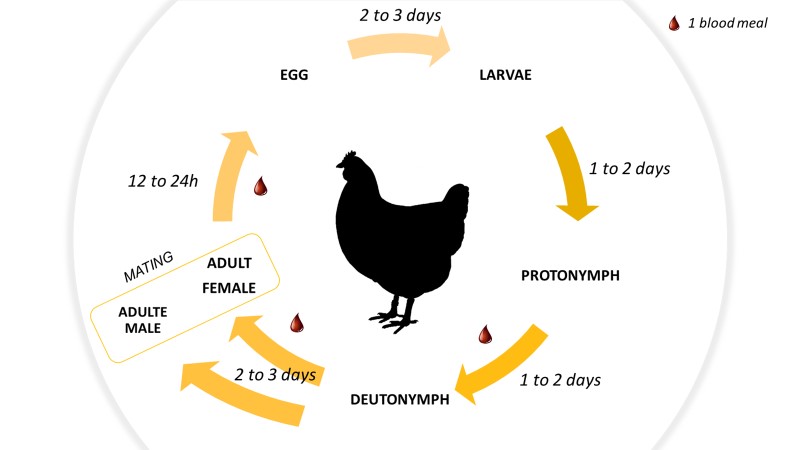
Red mite life cycle - Copyright Altilis
For a long time, the use of chemical insecticides has been the only possible way, what should we think of that?
Today, this choice is made increasingly complex by the general resistance of mites to these products: the number of allowed and effective insecticidal molecules is more and more restricted.
Red mites behave gregariously. During major infestations, they live in clusters. In the case of chemical spraying, insects inside the clusters are protected and not affected by insecticides.
Today, the chemical pathway is very limited due to the poor number of molecules available on the market and the local regulation in the countries. Products with adequate effectiveness should be sparingly used in order to limit the occurrence of insect resistance phenomena.
In addition, these solutions have a time-limited effect and generally require multiple applications that are costly for the farmer.
Finally, the problematic of molecule residue traces should also be taken into account in this kind of protocol. It is imperative to follow strictly manufacturer recommendations to avoid any risk to users, animals and environment. Not forgetting the final consumer’s request for a chemical free animal production.
Farmers are therefore looking for other effective means of action against this parasite.
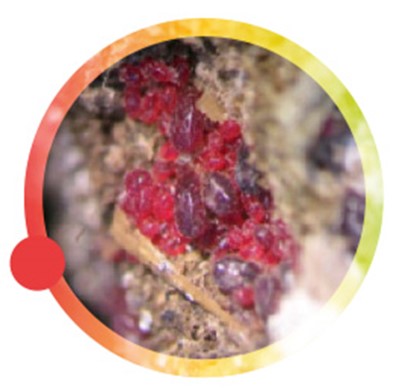
Red mites on wooden perch - Copyright Altilis
Are there any alternatives today?
Above all, good husbandry practices are vital. Ensuring proper cleaning and disinfection during the crawl space helps to control the sanitary initial status of the building. Effective control of pests such as wild birds or rodents is also a means to limit contamination sources.
Biological control is an interesting option. The principle is the use of insects which are natural mite predators. This technique is quite new with promising results but it is too early to measure its real effectiveness.
Another solution: silica-based products or diatomaceous earths. They act by insect desiccation, red mites dying from dehydration. These solutions are applied in powder form or through liquid spraying in the building. Although effective, the implementation of these products is a time-consuming process which generates uncomfortable dust for animals and farmers. This is made more even restrictive by the need of regular and multiple applications.
The feeding lever also represents a useful means of struggle in the day-to-day red mite management and seems to be a consensus within the sector.
Today, what are the current expectations of the feed industry to face this scourge?
The whole sector is receptive to find solutions to this problem considered as a major one but obviously not anyhow and by limiting the use of chemicals.
Primary requirement: looking for efficiency as a must by significantly reducing red mite challenge with a reasonable cost.
The way of application remains essential. Farmers are looking for easy, time-sparing and flexible-to-use solutions which are safe for themselves and their animals, free of toxic residues.
In this respect, many of these benefits come from solutions provided by feed industry. This is particularly the case for layer feed based on plants or plant extracts which can be combined with other solutions or used alone.
What can we expect from plant extracts distributed through feed or drinking water?
Herbal extracts are an interesting natural alternative to help poultry better resist mite infestations in addition to treatments.
Generally administered to hens through feed or drinking water, these solutions act both by supporting laying performance while improving animal welfare as well as the comfort of breeders.
There is a calming effect on animals with decrease of abnormal behaviours and mortality, associated with positive impact on performance. For example, there are fewer spotted eggs and improved annual egg production per hen.
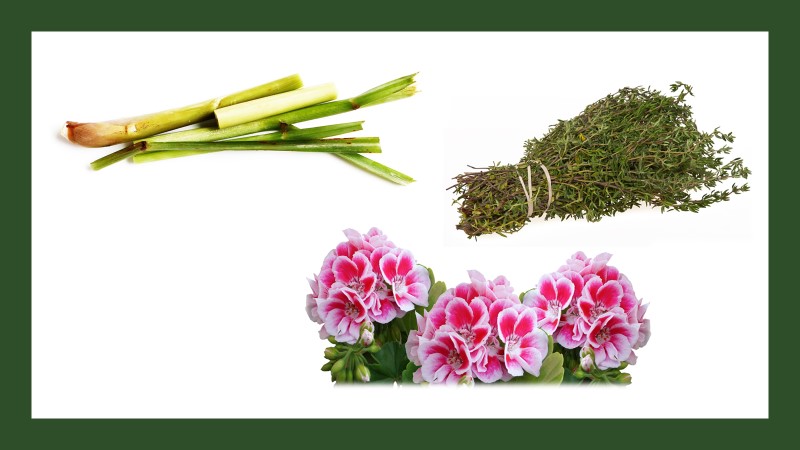
Examples of plants used for fighting red mites: thyme, geranium & lemongrass
Application through drinking water is to be preferred because it allows to target precisely the period of use, that is to say to put in place an adapted and effective protocol ensuring a perfect action on the red mite metabolism.
Indeed, in feed, it is essential to better anticipate feed deliveries, which reduces the flexibility of the system. To ensure an effective protocol, the necessary quantities remain important with a final high cost.
Thus, application through drinking water system remains for me the most effective alternative.

